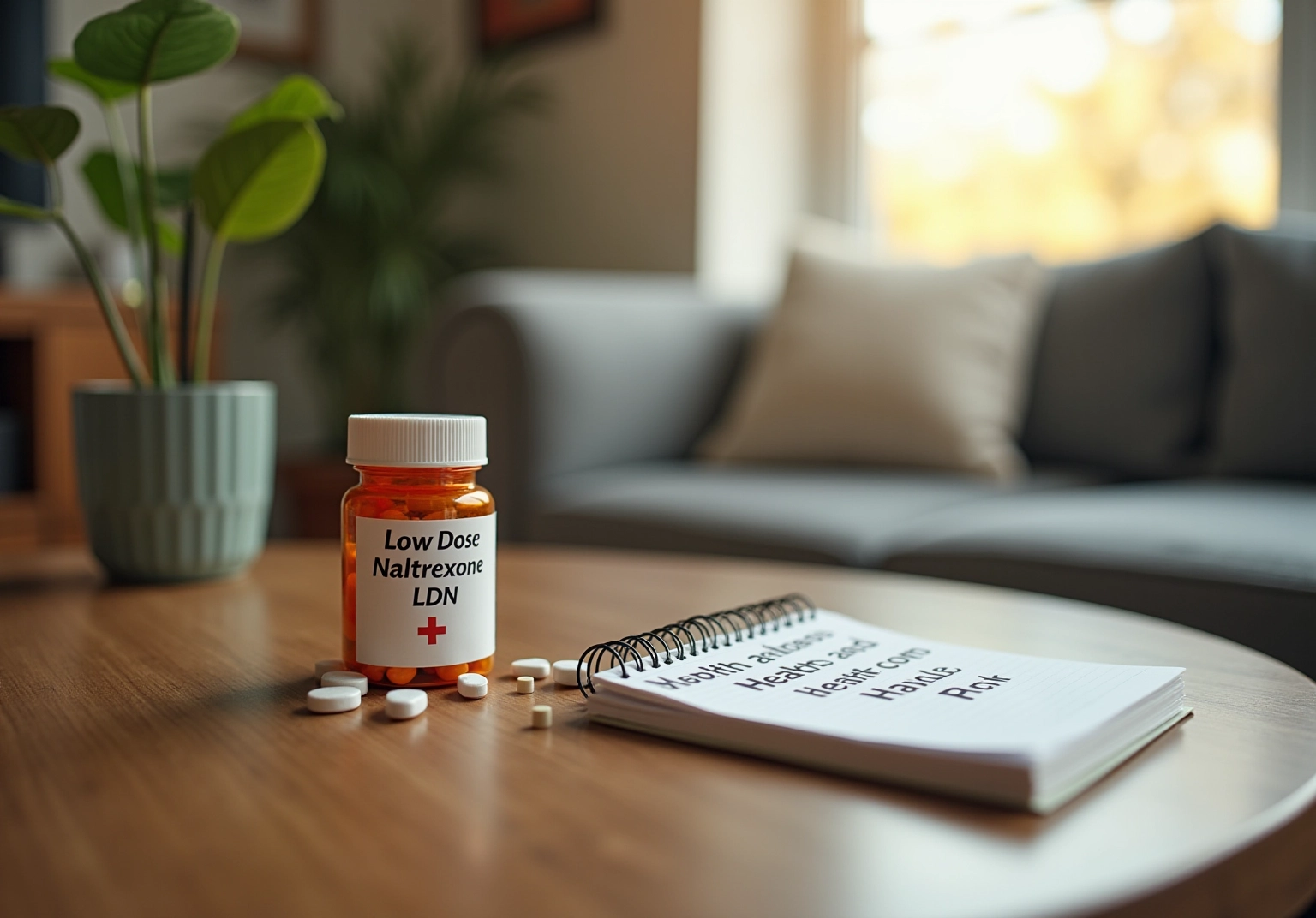How Long Does It Take LDN to Work for Inflammation?
Overview
Low Dose Naltrexone (LDN) is a treatment that can take several weeks to months to effectively alleviate inflammation. Individual responses to LDN vary significantly, influenced by factors such as overall health, dosage adherence, and the specific conditions being treated.
Research indicates that while some patients may notice improvements within weeks, others may require longer periods to experience significant benefits. This variability underscores the importance of personalized treatment plans tailored to each patient’s unique situation.
By understanding these dynamics, patients can engage in more informed discussions with their healthcare providers about the potential timeline and expectations for LDN therapy.
Introduction
Low Dose Naltrexone (LDN) has emerged as a surprising contender in the battle against chronic inflammation. Originally designed for opioid dependence, it is now recognized for its unique therapeutic properties. As more individuals seek alternatives to traditional anti-inflammatory treatments, understanding how LDN works and its timeline for effectiveness becomes crucial.
However, the variability in individual responses raises an intriguing question: how long does it truly take for LDN to demonstrate its anti-inflammatory effects, and what factors influence this timeline?
Understand Low Dose Naltrexone and Its Role in Inflammation
Low Dose Naltrexone (LDN) is a medication initially developed to address opioid dependence. However, its lower doses—typically ranging from 1 to 5 mg—have garnered attention for their potential anti-inflammatory properties. LDN works by temporarily blocking opioid receptors, which in turn triggers a rebound increase in endorphin production. This surge in endorphins can help modulate the immune response, leading to a reduction in inflammation.
Research indicates that LDN may be especially beneficial for conditions characterized by chronic inflammation, such as:
- Fibromyalgia
- Crohn’s disease
- Multiple sclerosis
For example, studies have shown that LDN can significantly lower levels of pro-inflammatory cytokines—molecules that signal and promote inflammation within the body. A systematic review revealed that LDN treatment resulted in an 18% decrease in overall symptoms among individuals with fibromyalgia, with 65% reporting a perceived benefit in pain relief. However, it is essential to acknowledge that the overall risk of bias was assessed as high in the studies included in this review, which may impact the reliability of these findings.
Furthermore, a pilot study highlighted that after eight weeks of LDN administration, it raised the question of how long does it take LDN to work for inflammation, as participants experienced a notable decrease in inflammatory markers. This suggests that LDN may function as an atypical anti-inflammatory agent. Negative reactions were reported by only 11% of individuals, with common side effects including nausea, headaches, and anxiety, indicating a predominantly positive safety profile. These findings emphasize the importance of understanding how long does it take LDN to work for inflammation in managing chronic conditions, offering a promising avenue for those seeking alternative treatment options.
In addition, the ongoing INNOVA study is currently recruiting women for a trial of 4.5 mg/day LDN, further contributing to the research landscape surrounding this medication.

Explore How Low Dose Naltrexone Works to Alleviate Inflammation
Low Dose Naltrexone (LDN) is known for its ability to reduce inflammation through multiple mechanisms. Primarily, it acts as an antagonist to opioid receptors, creating a temporary blockade that prompts the body to increase endorphin production—natural compounds that relieve pain. Elevated endorphin levels enhance the immune system’s ability to regulate inflammation effectively.
Furthermore, LDN modulates the opioid growth factor receptor pathway, which contributes to neuroprotection, a crucial aspect of brain health. In addition, LDN influences the activity of microglial cells in the central nervous system, which play a significant role in neuroinflammation. By reducing the activation of these cells, LDN can significantly decrease inflammation across various conditions.
The complexity and multifaceted nature of LDN’s mechanisms highlight its potential therapeutic benefits. Chronic inflammation is a known contributor to the development and progression of neurodegenerative diseases, making LDN’s anti-inflammatory effects particularly important. Clinical studies have indicated that individuals frequently observe a significant decrease in inflammatory markers and an enhancement in symptoms within weeks, raising the question of how long does it take LDN to work for inflammation.
For instance, a pilot trial indicated that LDN treatment was associated with a significant decrease in pro-inflammatory cytokines, supporting its role as an atypical anti-inflammatory medication. Additionally, research has highlighted LDN’s potential in managing chronic pain conditions, with many participants reporting enhanced quality of life and symptom relief after treatment. These findings underscore LDN’s promise as a therapeutic option for individuals dealing with inflammation-related health issues.

Identify Factors Affecting the Onset of LDN’s Effects on Inflammation
The onset of Low Dose Naltrexone (LDN) in alleviating inflammation can vary significantly among individuals, raising the question of how long does it take LDN to work for inflammation, which is influenced by several key factors. Primarily, an individual’s overall health status plays a crucial role; those with chronic conditions may experience different responses compared to healthier individuals. For instance, research shows that while some individuals report improvements within a few weeks, others may ask how long does it take LDN to work for inflammation, as they might require several months to observe substantial advantages. This variability can be attributed to factors such as metabolic rate, body weight, and the presence of comorbidities, which can all affect how long does it take LDN to work for inflammation and how it is metabolized and utilized by the body.
Moreover, adherence to the prescribed dosage is essential for optimal results. Patients typically start with a low dose, often beginning at 1.5 mg and gradually increasing to a maximum of 4.5 mg over a couple of months. This titration process is crucial, as effective dosing is highly personalized; research indicates that the effective dose can differ significantly among individuals, with some needing adjustments based on their unique reactions. Timing of administration also matters, with nighttime dosing recommended to align with the body’s natural endorphin production cycle, which peaks between 2:00 a.m. and 4:00 a.m.
Case studies further illustrate these points. In one study involving individuals with fibromyalgia, only 11 out of 25 subjects responded positively to LDN, emphasizing the significance of customized treatment plans. Furthermore, individuals with conditions such as Crohn’s disease have exhibited substantial improvement, with over 80% indicating decreased symptoms when treated with LDN. These findings underscore the necessity for patients to maintain open communication with their healthcare providers to tailor their treatment plans effectively, ensuring that the approach to LDN therapy is as individualized as the patients themselves. Additionally, considering the potential anti-aging benefits of LDN, as discussed in related posts, it is essential to explore how its anti-inflammatory properties may contribute to overall longevity and health optimization.

Recognize Potential Side Effects of Low Dose Naltrexone
Low Dose Naltrexone (LDN) is typically well-accepted among patients; however, some individuals may experience adverse reactions. Commonly reported issues include:
- Sleep disturbances
- Vivid dreams
- Gastrointestinal discomfort such as nausea or diarrhea
- Mild headaches
Studies show that these reactions are often short-lived, usually diminishing as the body acclimates to the medication.
It is crucial for individuals to closely monitor their reactions and consult with their healthcare provider if they experience persistent or severe symptoms. Research indicates that roughly 36% of individuals stop using LDN due to adverse reactions, emphasizing the significance of understanding and addressing these possible responses.
Furthermore, patients should be aware of potential long-term concerns associated with LDN, such as immune dysregulation and liver function issues. Regular liver function tests are recommended every 6 to 12 months for those on LDN to ensure safety. By being informed about the common side effects and their prevalence, individuals can make educated decisions regarding their treatment and effectively address any adverse effects that may arise.

Conclusion
Low Dose Naltrexone (LDN) emerges as a promising alternative for managing inflammation, particularly for individuals suffering from chronic conditions. Its unique mechanism, which involves temporarily blocking opioid receptors to boost endorphin production, highlights LDN’s potential to modulate the immune response and alleviate inflammation effectively. Understanding the timeline for LDN’s effects is crucial for patients seeking relief from inflammatory symptoms.
Throughout the article, key insights reveal that LDN’s onset of action can vary based on individual health factors, dosage adherence, and specific conditions being treated. Research demonstrates that:
- Some patients may notice improvements within weeks.
- Others might require a longer duration to experience significant benefits.
Furthermore, attention to potential side effects is essential, as most reactions are mild and temporary, underscoring the need for ongoing communication with healthcare providers.
In conclusion, LDN represents a significant advancement in the quest for effective anti-inflammatory treatments. As ongoing studies continue to explore its efficacy, patients are encouraged to consider LDN as a viable option for managing inflammatory conditions. Embracing this treatment could lead to improved quality of life and symptom relief. Therefore, it is essential for individuals to discuss LDN with their healthcare providers to tailor their approach to inflammation management.
Frequently Asked Questions
What is Low Dose Naltrexone (LDN)?
Low Dose Naltrexone (LDN) is a medication originally developed to treat opioid dependence, but lower doses (typically 1 to 5 mg) are being explored for their potential anti-inflammatory properties.
How does LDN work to reduce inflammation?
LDN works by temporarily blocking opioid receptors, which triggers a rebound increase in endorphin production. This surge in endorphins can help modulate the immune response, leading to reduced inflammation.
What conditions may benefit from LDN due to its anti-inflammatory effects?
LDN may be especially beneficial for conditions characterized by chronic inflammation, such as fibromyalgia, Crohn’s disease, and multiple sclerosis.
What does research say about the effectiveness of LDN for fibromyalgia?
Research indicates that LDN treatment resulted in an 18% decrease in overall symptoms among individuals with fibromyalgia, with 65% reporting a perceived benefit in pain relief.
Are there any concerns regarding the reliability of LDN studies?
Yes, the overall risk of bias was assessed as high in the studies included in the review, which may impact the reliability of the findings.
How long does it take for LDN to work for inflammation?
A pilot study suggested that after eight weeks of LDN administration, participants experienced a notable decrease in inflammatory markers, indicating that it may take some time for LDN to show its effects.
What are the common side effects of LDN?
Common side effects reported include nausea, headaches, and anxiety, but negative reactions were noted by only 11% of individuals, indicating a predominantly positive safety profile.
Is there ongoing research related to LDN?
Yes, the ongoing INNOVA study is currently recruiting women for a trial of 4.5 mg/day LDN, contributing to the research landscape surrounding this medication.






